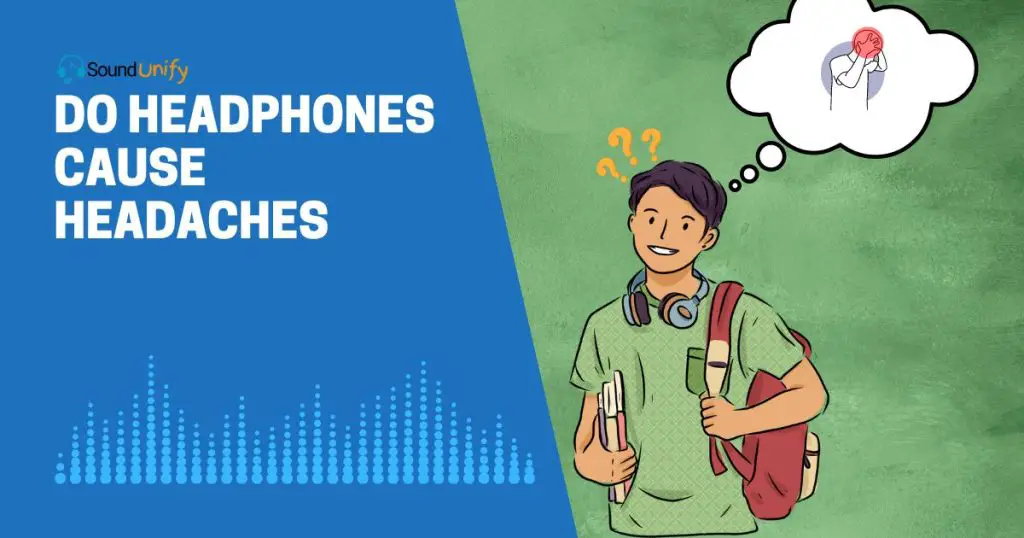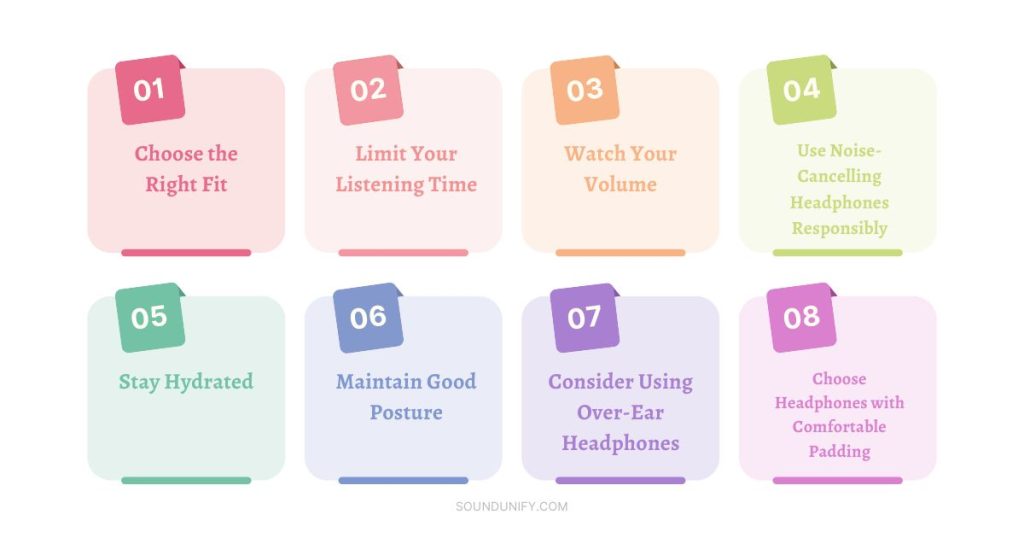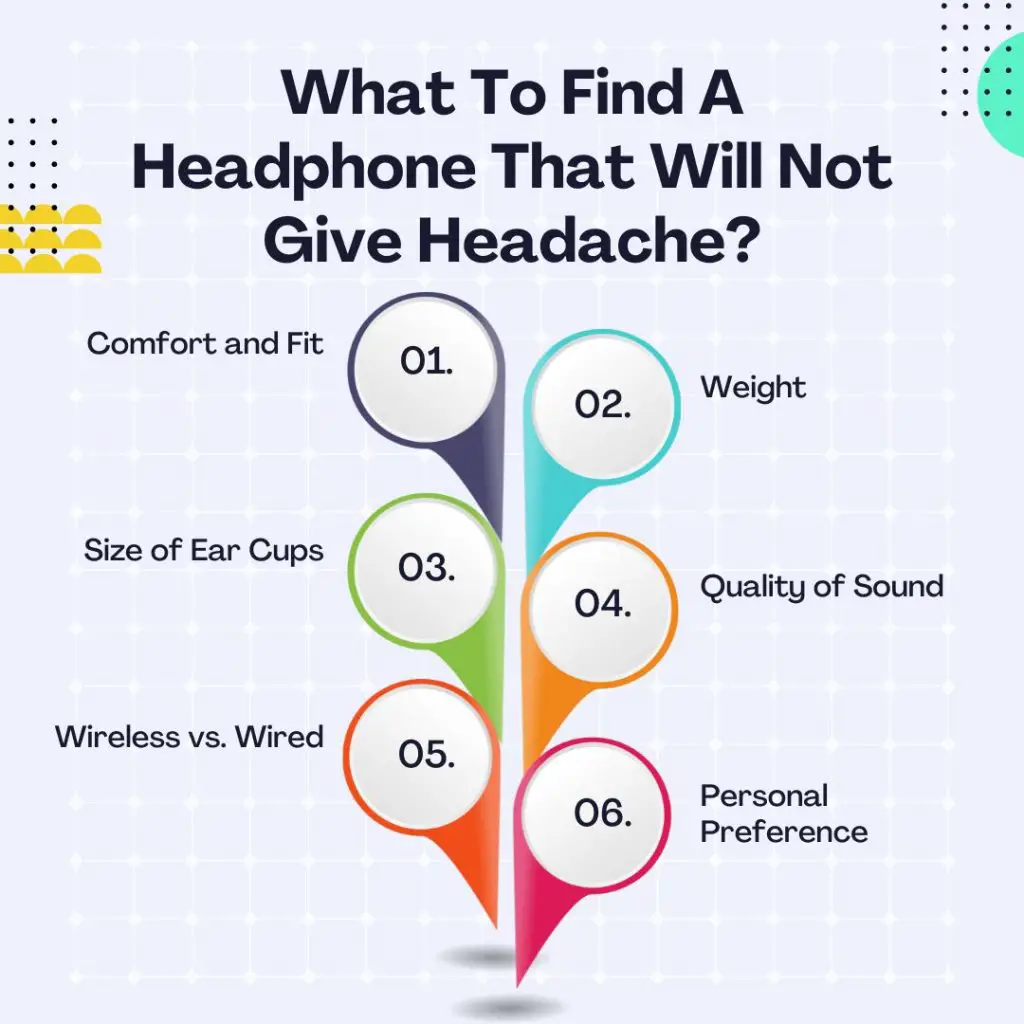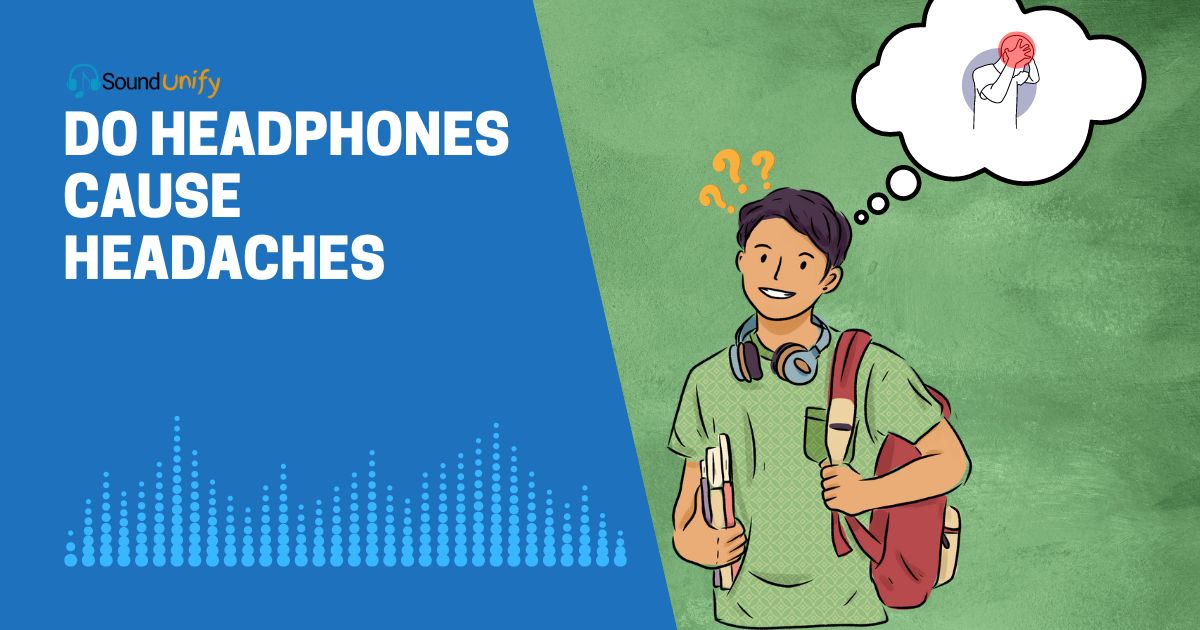Yes, headphones can cause headaches. But it's not as simple as it seems.
I’m sure many of you have experienced that nagging headache after a long session of your favorite tunes. It’s a bummer. Well, we’re diving into the question that’s probably been buzzing in your head (pun intended): Do headphones cause headaches?
Now, I know what you’re thinking. “I love my music, don’t take it away!” Don’t worry; I’m not here to do that. But it’s important to understand that headphones aren’t the villain.
They can contribute to discomfort if not used properly. Several factors are at play, from excessive volume levels to poor fit.
So, please stick with me as we unravel this mystery together. Let’s explore how we can enjoy our beats without the unwanted side effects.

13 Reasons Why Headphones Give Me a Headache
I’m experiencing headaches sometimes when I wear headphones. It’s confusing and slightly problematic because I love music, and it’s becoming problematic. As I have understood, this can be due to a variety of reasons:
1. Tight Headphones
When I first started using headphones, I made the mistake of choosing a pair that was too tight. I quickly realized that this was causing discomfort and even headaches.
Headphones that are too tight exert excessive pressure on your head and ears. This pressure can lead to discomfort and a headache. It’s similar to wearing a too-tight hat – you start feeling a dull ache after a while.
Here are a few tips to avoid this issue:
- Try Before You Buy: If possible, try on headphones before purchasing them to ensure they fit comfortably.
- Adjust the Headband: Many headphones have adjustable headbands. Adjust it so that it fits snugly but not too tightly.
- Take Breaks: Taking regular breaks can help relieve the pressure caused by tight headphones.
2. Poorly-Fitting Headphones
Poorly-fitting headphones can cause various problems, from minor discomfort to severe headaches. If the headphones are too loose, they might not stay in place, causing you to adjust them constantly.
On the other hand, if they’re too tight, they can exert pressure on your head and ears.
Here’s what you can do to ensure a good fit:
- Check the Size: Make sure the headphones are the right size for your head and ears. They should not be too tight or too loose.
- Adjust as Needed: Most headphones have adjustable headbands and ear cups. Use these features to achieve a comfortable fit.
- Try Different Styles: If one style of headphones doesn’t fit well, try another. You might find that on-ear headphones fit better than over-ear ones, or vice versa.
3. Padding for Shallow Ear Cups
Shallow ear cup padding can cause discomfort and potentially lead to headaches. This is because the padding on the ear cups provides cushioning between the headphones and your ears.
If the padding is too shallow, your ears might come into contact with the complex parts of the headphones, causing discomfort.
Here’s how to avoid this issue:
- Look for Thick Padding: When choosing headphones, look for ones with thick, plush padding on the ear cups.
- Consider Material: The material of the padding can also affect comfort. Memory foam padding tends to be more comfortable than other types.
- Try Them On: If possible, try on the headphones before buying them to ensure the padding is comfortable.
4. Allergic Reaction to Headphones
Some people might experience an allergic reaction to the materials used in headphones. This can cause itching, redness, and discomfort, contributing to headaches.
Here’s what you can do if you suspect you’re having an allergic reaction:
- Identify the Cause: Try to identify the material causing the reaction. Common culprits include certain types of plastic, rubber, or metal.
- Choose Hypoallergenic Options: Some headphones are made with hypoallergenic materials. These might be a good option if you have sensitive skin.
- Use Covers: If you can’t find hypoallergenic headphones, consider using headphone covers. These can provide a barrier between your skin and the headphones.
5. Sinus Pressure
Sinus pressure is another reason why headphones might give you a headache. The pressure from the headphones can exacerbate existing sinus pressure, leading to discomfort and a headache.
This is especially true if you’re already prone to sinus issues or experiencing a sinus infection or allergies.
Here’s what you can do to mitigate this issue:
- Choose Lighter Headphones: Lighter headphones exert less pressure on your head and sinuses.
- Take Breaks: Regular breaks can help relieve sinus pressure caused by headphones.
- Treat Sinus Issues: If you have ongoing sinus issues, treating them can help reduce headphone-induced headaches.
6. Medication Side Effects
Certain medications can make you more susceptible to headaches, and using headphones might exacerbate this side effect.
If you’ve recently started a new medication and are experiencing more headaches when using headphones, the medication might be the culprit.
Here’s what you can do if you suspect your medication is causing headaches:
- Consult Your Doctor: If you suspect your medication is causing headaches, consult your doctor. They might be able to adjust your dosage or switch you to a different medication.
7. Sleep Deprivation
Lack of sleep can make you more susceptible to headaches. You might be more prone to headaches if you use headphones while sleep-deprived.
This is because your body and brain are already under stress due to lack of sleep, and the additional strain from the headphones can push you over the edge into a headache.
Here’s how to avoid this issue:
- Get Enough Sleep: Make sure you’re getting enough sleep each night. The exact amount varies from person to person, but most adults need between 7 and 9 hours.
- Use Headphones Responsibly: If you’re sleep-deprived, limit your headphones until you can catch up on sleep.
8. Eye Strain
If you’re using headphones while staring at a screen, the combination of eye strain and auditory focus can lead to headaches. This is especially true if you’re using headphones for tasks requiring much concentration, like gaming or editing videos.
Here’s what you can do to reduce eye strain:
- Take Regular Breaks: The 20-20-20 rule is good to follow: every 20 minutes, look at something 20 feet away for 20 seconds.
- Adjust Your Screen: Make sure your screen is at a comfortable distance and angle, and adjust the brightness and contrast as needed.
9. Ear Tips Size
If you’re using in-ear headphones, the ear tips can significantly affect comfort. If the ear tips are too big, too small, or just the wrong shape for your ears, they can cause discomfort and headaches.
Here’s how to find the right ear tips:
- Try Different Sizes: Most in-ear headphones come with multiple sizes of ear tips. Try different sizes to see which one fits best.
- Consider Different Materials: Ear tips can be made of different materials, like silicone, foam, or rubber. You might find one material more comfortable than the others.
- Consider Custom Ear Tips: If you can’t find a comfortable fit with the included ear tips, consider getting custom ear tips. These are made to fit your ears exactly, providing the most comfortable fit.
10. Wearing Headphones Long Time
Excessive use of headphones is a common cause of headaches. When you wear headphones for long periods, it can strain your ears and the surrounding muscles.
This strain can lead to discomfort and, eventually, a headache. I’ve found that taking regular breaks is crucial to prevent this.
Here’s what you can do to avoid this issue:
- Take Regular Breaks: Take a break every hour to rest your ears.
- Limit Daily Use: Limit how many hours you use headphones daily. If possible, switch to speakers or other audio devices occasionally.
11. Loud Environments
Using headphones in loud environments can also lead to headaches. You might be tempted to turn up the volume to drown out the background noise, but this can lead to auditory strain and, eventually, a headache.
Here’s what you can do to mitigate this issue:
- Use Noise-Cancelling Headphones: These headphones can help reduce background noise, allowing you to listen at a lower volume.
- Find a Quieter Environment: If possible, try to find a quieter environment to use your headphones.
12. Using Headphones That Don’t Fit With Glasses.
Finding headphones that fit comfortably can be challenging if you wear glasses. The arms of your glasses can interfere with the headphones, causing pressure points and discomfort that can lead to headaches.
Here’s what you can do to find a comfortable fit:
- Choose Over-Ear Headphones: These headphones are more comfortable for glasses wearers because they put less pressure on the sides of your head.
- Look for Glasses-Friendly Headphones: Some headphones are designed to be comfortable for glasses wearers. They have softer padding or unique cutouts to accommodate the arms of glasses.
13. Headphones That Are Not Designed for Your Ears
Just like shoes, headphones need to fit correctly to be comfortable. If your headphones are not designed for your ears, they can cause discomfort and headaches.
Here’s what you can do to find the right headphones for your ears:
- Try Different Styles: There are many different styles of headphones, including over-ear, on-ear, and in-ear. You might find one style more comfortable than the others.
- Look for Adjustable Features: Some headphones include swiveling ear cups or interchangeable ear tips. These can help you achieve a better fit.
- Consider Custom Headphones: If you can’t find a comfortable fit with off-the-shelf headphones, consider getting custom headphones. These are made to fit your ears exactly, providing the most comfortable fit.
Can Over-Ear Headphones Cause Headaches?
Yes, over-ear headphones can cause headaches. I can attest to this as someone who has used various headphones.
Over-ear headphones, while often providing superior sound quality, can pressure the head and ears, especially when worn for extended periods. This pressure can lead to discomfort and, eventually, a headache.
Moreover, if the headphones are too tight or don’t fit properly, they can exacerbate this issue. It’s similar to wearing a too-tight hat – you start feeling a dull ache after a while.
Additionally, the noise isolation provided by over-ear headphones can sometimes lead to increased volume levels, which can cause auditory strain and contribute to headaches.
So, while over-ear headphones have many benefits, using them responsibly to avoid potential headaches is essential. This includes taking regular breaks, adjusting the fit as necessary, and keeping the volume safe.
How To Prevent Headaches From Headphones?

As someone who has experienced headaches from headphones, I can share some practical strategies that have helped me prevent this discomfort.
1. Choose the Right Fit:
The first step in preventing headaches is to choose headphones that fit well. Too tight, and they can exert pressure on your head and ears; too loose, and you might find yourself constantly adjusting them, which can also lead to discomfort.
2. Limit Your Listening Time:
Prolonged use of headphones can lead to auditory fatigue, resulting in headaches. I’ve found that taking regular breaks can help prevent this. Try to take a break every hour or so, even if it’s just for a few minutes.
3. Watch Your Volume:
Listening to music or other audio at high volumes can cause auditory strain and headaches. I always try to keep the volume at a safe level. A good rule of thumb is to set your volume no higher than 60% of the maximum volume.
4. Use Noise-Cancelling Headphones Responsibly:
While noise-canceling headphones can help reduce background noise, some people (including myself) find that they can cause a sensation of pressure, leading to headaches. If you use noise-canceling headphones, it might be worth turning off the noise-canceling feature now and then to give your ears a break.
5. Stay Hydrated:
Dehydration can lead to headaches. Drink plenty of water if you’re using headphones for a long time, especially in hot conditions.
6. Maintain Good Posture:
Poor posture can contribute to tension headaches. If you’re hunching over a device while using headphones, try maintaining good posture to prevent this.
7. Consider Using Over-Ear Headphones:
Over-ear headphones can be more comfortable for some people, as they evenly distribute the pressure around your ears rather than pressing down on them.
8. Choose Headphones with Comfortable Padding:
Headphones with soft, plush padding can be more comfortable and less likely to cause headaches.
What To Find A Headphone That Will Not Give Headache?

Finding headphones that won’t give you a headache involves considering several factors. As someone who has navigated this process, I can share some tips that might help you.
- Comfort and Fit: The most important factor is comfort. Look for headphones that have soft padding and are adjustable. They should fit snugly but not too tightly. Over-ear headphones often provide the most comfort for extended use.
- Weight: Lighter headphones can reduce the amount of pressure on your head and ears. If you plan to wear your headphones for extended periods, consider the weight of the headphones before purchasing.
- Size of Ear Cups: The size of the ear cups can also contribute to comfort. Larger ear cups can distribute pressure more evenly around your ears, reducing the chance of discomfort.
- Quality of Sound: High-quality sound can also help prevent headaches. Poor sound quality can cause you to reduce the volume, leading to auditory strain and headaches. Look for headphones with good sound quality and, if possible, noise-canceling capabilities.
- Wireless vs. Wired: Wireless headphones can provide more freedom of movement, which can help prevent tension and strain. However, they do need to be charged regularly.
- Personal Preference: Everyone is different, so what works for me might not work for you. You might prefer in-ear, on-ear, or over-ear headphones. You might find certain brands more comfortable than others. It’s essential to try different options and find what works best for you.
Table: Tips for Finding Headphones That Won’t Give You a Headache
| Factor | Tips |
|---|---|
| Comfort and Fit | Look for soft padding and adjustable features. |
| Weight | Lighter headphones can reduce pressure on your head and ears. |
| Size of Ear Cups | Larger ear cups can distribute pressure more evenly. |
| Quality of Sound | High-quality sound can prevent the need for high volume. |
| Wireless vs. Wired | Wireless headphones provide more freedom of movement. |
| Personal Preference | Try different options to find what works best for you. |
Remember, if you frequently experience headaches while or after using headphones, it’s essential to consult with a healthcare professional to rule out any severe underlying conditions.
Headphones That Don’t Cause Headaches
Finding headphones that don’t cause headaches can be a bit of a personal journey, as everyone’s comfort levels and preferences are different. However, a few models are often recommended for their comfort and quality.
Here are a few options:
- Bose QuietComfort 35 II: These are over-ear headphones known for their comfort and excellent noise-cancellation capabilities. They have a lightweight design and plush ear cups, which can help reduce the pressure on your ears.
- Sennheiser HD 599: These open-back headphones are praised for their comfort. They have large, velour-covered ear cups that fit comfortably around most ears, reducing the pressure.
- Sony WH-1000XM4: These are another pair of over-ear headphones often recommended for comfort. They have a lightweight design, soft ear cups, and excellent noise-cancellation capabilities.
- Audio-Technica ATH-M50x: These headphones are known for their sound quality and comfort. They have professional-grade earpads and headband material, offering more durability and comfort.
- Jabra Elite 85h: These headphones are designed with comfort in mind, featuring soft leather ear cups and an adjustable headband. They also have excellent sound quality and active noise cancellation.
FAQs
Q: Is it True That Headphones Cause Headaches?
A: Yes, headphones can indeed cause headaches, but it’s not the headphones themselves that are the culprits. It’s more about how we use them. Wearing them too long, having them too tight, or listening at high volumes can all contribute to headaches.
So, while your beloved headphones aren’t out to get you, it’s worth using them responsibly to keep those headaches at bay.
Q: Are earphones bad for headaches?
A: Not necessarily. Earphones, like headphones, can contribute to headaches if misused. However, if you’re choosing earphones that fit well, keeping the volume safe, and taking regular breaks, you should be able to enjoy your music headache-free. It’s all about balance, my friend!
Q: Can Bluetooth earbuds cause headaches?
A: Bluetooth earbuds themselves are unlikely to cause headaches. However, if they do not fit correctly or you’re using them for extended periods without breaks, they could contribute to headaches.
It’s also worth noting that some people may be sensitive to the pressure sensation caused by specific noise-canceling earbuds.
So, while Bluetooth isn’t the headache-inducing villain here, using your earbuds responsibly is still essential.
Q: Why do Bluetooth headphones give me a headache?
A: If your Bluetooth headphones give you a headache, it might be due to a few factors. It could be that they’re too tight, you’re listening at high volumes, or you’re wearing them for too long without breaks
Also, some people might find the sensation of noise-cancellation in certain headphones uncomfortable. It’s worth experimenting with different fit settings, volume levels, and break intervals to see if you can banish those headaches.
Q: Why does my head hurt after listening to music with headphones?
A: If your head hurts after listening to music with headphones, it could be a sign that you’re listening too loudly or for too long.
Our ears aren’t designed to process loud sounds for extended periods, and doing so can lead to auditory strain and headaches.
Try turning down the volume and taking regular breaks. And remember, your favorite tunes should bring joy, not headaches.
Final Thoughts
In my experience, headphones can indeed cause headaches, but it’s important to remember that it’s not the headphones themselves that are the issue. It’s more about how we use them.
Wearing too tight headphones, listening at high volumes, or using them for extended periods can all contribute to discomfort.
However, enjoying your favorite tunes without the accompanying headache is possible with mindful usage and regular breaks.
After all, music is meant to be a source of joy and relaxation, not discomfort. So, let’s keep it that way!
James Dimento is a Chief-in-Editor of SoundUnify. He is a headphone enthusiast and creative writer passionate about audio technology. He has three years of experience writing about headphones and sound quality and is responsible for creating reviews and taking care of all administration.
